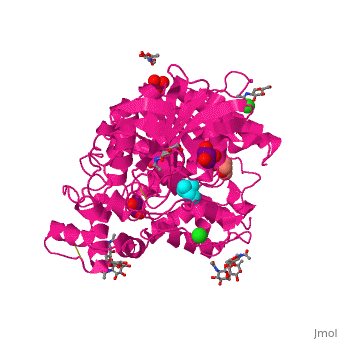Butyrylcholinesterase
From Proteopedia
(Difference between revisions)
| Line 4: | Line 4: | ||
== Function == | == Function == | ||
| - | [[Butyrylcholinesterase]] (BChE) is an enzyme widely distributed throughout the body in humans, but particularly prevalent in serum, where it occurs as a tetramer of catalytic subunits. It is distinguished from the homologous enzyme, acetylcholinesterase, by its ability to hydrolyze the non-natural substrate butyrylcholine as well as the neurotransmitter, acetylcholine. | + | [[Butyrylcholinesterase]] (BChE) is an enzyme widely distributed throughout the body in humans, but particularly prevalent in serum, where it occurs as a tetramer of catalytic subunits. It is distinguished from the homologous enzyme, acetylcholinesterase, by its ability to hydrolyze the non-natural substrate butyrylcholine as well as the neurotransmitter, acetylcholine. <ref>PMID:12563284</ref> |
== Relevance == | == Relevance == | ||
Revision as of 11:48, 18 November 2015
| |||||||||||
3D structures of BChE
Updated on 18-November-2015
Additional Resources
For additional information, see: Alzheimer's Disease
References
- ↑ Darvesh S, Hopkins DA, Geula C. Neurobiology of butyrylcholinesterase. Nat Rev Neurosci. 2003 Feb;4(2):131-8. PMID:12563284 doi:http://dx.doi.org/10.1038/nrn1035
- ↑ Nicolet Y, Lockridge O, Masson P, Fontecilla-Camps JC, Nachon F. Crystal structure of human butyrylcholinesterase and of its complexes with substrate and products. J Biol Chem. 2003 Oct 17;278(42):41141-7. Epub 2003 Jul 17. PMID:12869558 doi:http://dx.doi.org/10.1074/jbc.M210241200
Proteopedia Page Contributors and Editors (what is this?)
Michal Harel, Alexander Berchansky, Lakshmi Venkatachalam, Joel L. Sussman, Jaime Prilusky, David Canner

